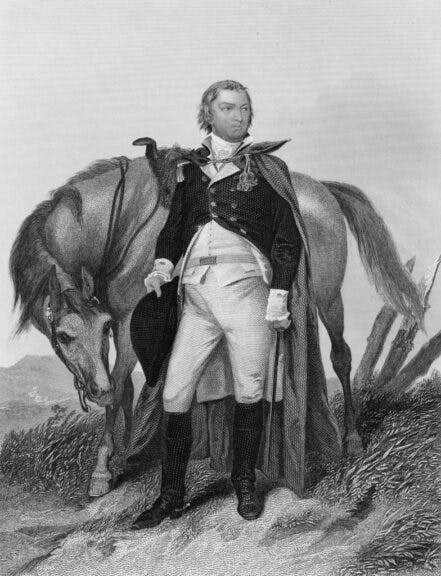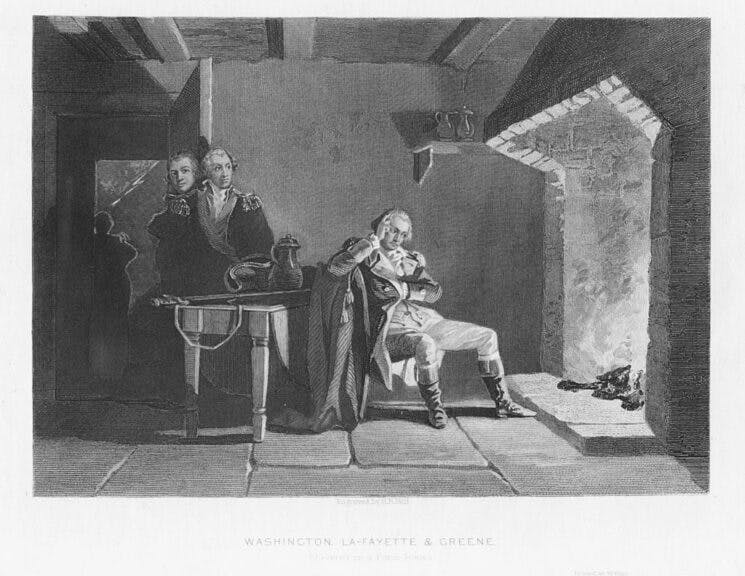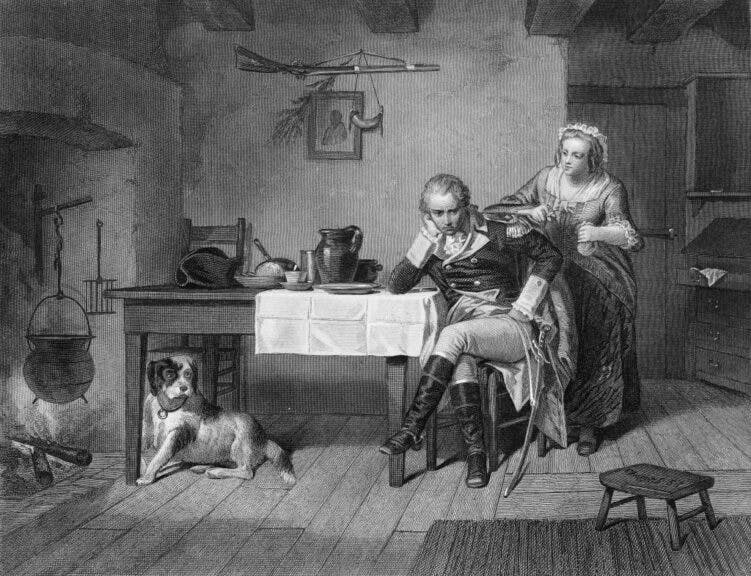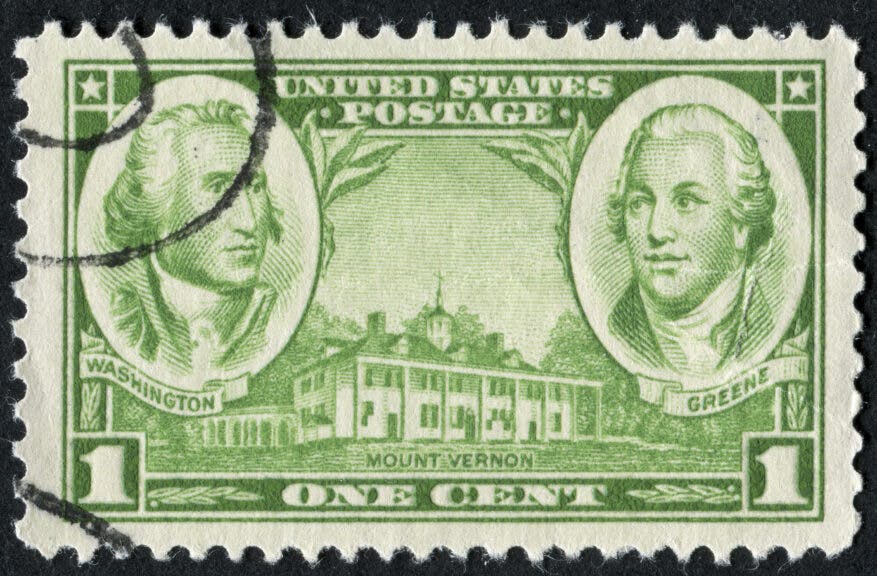Over the years, the United States has produced many remarkable generals and admirals, but only a few have stood out as world-class strategists and leaders of troops. As Veterans Day approaches on November 11, let’s remember and celebrate them. Here is my list of America’s finest 11 commanders.
Nathanael Greene, 1742 – 1786 (Revolutionary War)
A Rhode Island foundry-owner by trade, Nathanael Greene was emblematic of the citizen-soldier. At age 33, he was the youngest general in the fledgling Continental Army; unlike his peers, the Quaker Greene had had no military experience prior to his arrival with his Rhode Islanders in the burgeoning Patriot camp outside Boston in 1775. His knowledge of military dicta came almost entirely from books.

Major General Nathanael Greene (1742 – 1786) of the Continental Army during the American Revolutionary War, circa 1775. From an original by Chappel. (Photo by Kean Collection/Getty Images)
Indeed, Greene had little formal education of any kind, given his Quaker father’s “prejudices against literary accomplishments.” So, he educated himself. Still, he would confess, “I lament the want of a liberal education. I feel the mist [of] ignorance to surround me.” But this was no impediment to the resourceful Greene. With his intuitive understanding of military matters and protocols, including the importance of discipline and drilling as well as proper hygiene in the field, something much overlooked in Washington’s army when it first formed, Greene’s troops stood out as among the most reliable and professional in the still rag-tag Continental Army. Washington identified Greene right away as “an object of confidence.”

Engraved scene depicting George Washington contemplating in front of a fireplace, watched by General Nathanael Greene and the Marquis de Lafayette, during the American Revolutionary War, circa 1780. Engraved by H B Hall. (Photo by Archive Photos/Getty Images)
It was, therefore, the steadfast Greene whom Washington turned to both for counsel as well as holding the line at particularly difficult places. It was Greene’s stout fighters who held off British bayonets to cover the Continentals’ retreat from the Battle of Brandywine in September 1777, preventing a withdrawal from degenerating into a rout. A selfless patriot, Greene also reluctantly served as Washington’s quartermaster, a role as vital to keeping any army in fighting condition as field drills. His capacity for organization and attending to detail he learned from business served the country well. There was little the enterprising and energetic Greene could not accomplish. Washington so respected the Rhode Islander that he made it known that should he fall, Greene was to take command of the Continental Army.
Greene’s true military talents blossomed when he took command of the southern detachment of the Continental Army during the campaign of 1780-1781. Sent by Washington to give teeth to the flagging southern cause (Charleston had been captured in May 1780 along with its 5,500 patriot defenders), the wily Greene led the aggressive British Lord Cornwallis, Banaster Tarleton and others on a wild chase through the Carolinas and southern Virginia. Defying military convention, Greene often split his forces to stay ahead of the pursuing British. When he did stand and fight, even if eventually ceding the field as at Guilford Courthouse in March 1781, Greene’s army nonetheless often inflicted higher casualties on the British, draining their strength and morale in pyrrhic victories. “We fight, get beat, rise, and fight again” was Greene’s mantra.

Major General Nathanael Greene (1742 – 1786) of the Continental Army receives unexpected funds from innkeeper Elizabeth Maxwell Steele at her tavern in Salisbury, North Carolina, during the American Revolutionary War, 2nd February 1781. Engraved by J. B. Hall after a painting by Alonzo Chappel. (Photo by Kean Collection/Getty Images)
Understanding that he was fighting a hybrid conventional and guerilla campaign, Greene managed to integrate his Continentals with local militia to create a cohesive fighting force that kept Cornwallis off balance —giving local commanders like Lafayette and Dan Morgan much latitude while offering advice without direct interference — and eventually compelled the British general to remove his army to Yorktown, Virginia —where it met its ultimate destruction. By the time Greene’s operations in the South were completed, the British, who once held deep tracts of territory, had been reduced to a scattering of coastal toeholds.
Says historian Russell Weigley of Greene’s campaign in the South: “Greene’s outstanding characteristic as a strategist was his ability to weave the maraudings of partisan raiders into a coherent pattern, coordinating them with the maneuvers of a field army otherwise too weak to accomplish much, and making the combination a deadly one…. [He] remains alone as an American master developing a strategy of unconventional war.”
After Yorktown, Greene struggled to finance the southern army under his command. By the war’s official end in 1783 he’d incurred heavy debts to personally pay for his men’s provisions and equipment. As with Washington, Greene resigned his commission and set about rebuilding his lost fortune. Debts prompted him to leave Newport and re-establish himself in Georgia on a plantation outside Savannah that had been granted him by a grateful government. The northern Greene succumbed to heat stroke and died at age 43.
Nathanael Greene was by no means infallible. He was the one most responsible for persuading Washington to try and hold the Hudson River Forts Washington and Lee, only to see the entire garrison, some 3,000 men who were invaluable to the rapidly dwindling Continental Army, surrender and be marched off into captivity.
While lamenting the fate of his soldiers languishing in the sweltering holds of disease-ridden prison ships anchored in the Hudson, Washington agonized over the loss.
Yet, Washington never lost confidence in his most talented subordinate whose fierce desire to close with the enemy belied his Quaker roots. Greene rewarded Washington’s continued trust in the subsequent years, becoming one of the United States’ great generals. Defense analyst Robert Killebrew calls Greene “The second-best American general of the Revolutionary War” behind Washington himself.

Cancelled Stamp From The United States Featuring George Washington And Nathanael Greene Along With Mount Vernon. Getty Images.
Although Greene was known for his robust physique, a childhood accident left him with a stiff right leg and a limp. But that did not impede the indefatigable Greene. When a dancing partner once complained that he danced stiffly due to his old injury, Greene confidently replied: “Very true, but you see I dance strong.” It is hard for a man like that to not succeed. And fortunately for the Revolution, Greene turned out to be just the man Washington needed to help bring about victory and, just as important during some very desperate days, stave off defeat.
* * *
America’s Top 11 Generals
* * *
Brad Schaeffer is a commodities trader, columnist, and author of two acclaimed novels. His newest book, the fact-based LIFE IN THE PITS: My Time as a Trader on the Rough-and-Tumble Exchange Floors will be published in December and is currently available for pre-order. You can also find more of Brad’s articles on Substack.
The views expressed in this piece are those of the author and do not necessarily represent those of The Daily Wire.

Continue reading this exclusive article and join the conversation, plus watch free videos on DW+
Already a member?

.png)
.png)

